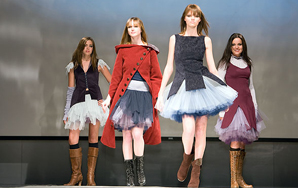The Un-Democracy Of Fashion Blogging
‘Personal style’ bloggers have garnered an almost infallible legitimacy as purveyors and creators of sartorial news, and their following has boomed to a cult-like status. As these blogs have gained intense popularity and more prolific bloggers have established an online celebrity, the democratic value of blogging is becoming increasingly undermined.
By ![]() Kat George
Kat George

I used to write and curate a popular Australian fashion blog which I discontinued mid-2010 for various reasons, both personal and ethical. The ‘personal style’ fashion blog—a phenomenon that gained serious momentum around 2005-6—was originally a means of harnessing the awesome power of the Internet and new digital technologies to democratize our perspective of contemporary fashion. By challenging traditional, or ‘glossy’, notions of beauty and defying the mainstream in order to reshape societal norms and expectations from a citizen viewpoint, blogs across all genres can and have served as powerful social tools. Women (those with access to the Internet; and access is a whole other can of worms in terms of Internet democracy debates), through personal style blogs, were presented in a new, subversive outlet in which they could use the power of contemporary technology to launch their personal voice, and a diverse array of notions of ‘beauty’ into the fray of public discourse.
However, ‘personal style’ bloggers have garnered an almost infallible legitimacy as purveyors and creators of sartorial news, and their following has boomed to a cult-like status. As these blogs have gained intense popularity and more prolific bloggers have established an online celebrity, the democratic value of blogging is becoming increasingly undermined. As an ex-fashion blogger, I have always been interested in the way fashion blogging has breached the mainstream, and the way in which fashion bloggers are essentially forcing democratized notions of beauty into a ‘glossy’ redux, joining the mainstream in the proliferation of information. Renowned fashion bloggers have essentially infiltrated the popular consciousness—whether through real time employment, product endorsements, corporate support or some other means—and as a result their blogs are creating virtual dogma, insofar as their status makes them authorities on fashion and style. In short, the word of a popular fashion blogger has ceased to be a subjective contribution to cultural discourse but rather an objective statement of fact. With such blogs on the fast track to becoming isolated capsules, where the blogger’s word is unquestioned gospel, ‘interactive’ has come to mean little more than sporadic comments of gushing approval or vitriol from readers, and a great deal of audience consumption of the products and branding fashion bloggers espouse.
What concerns me is what happens when the everywoman is nothing more than a shill—a curated example of the glossy ideals that continue to terrorise femininity and perceptions of femininity in the mainstream media. When fashion bloggers essentially become caricatures of themselves—with professional photography, unrealistic beauty and lucrative deals for product placement, what message is being sent to the other side of the screen? We’ve been taught to adopt a certain level of cynicism when reading glossies, but the same grain of salt has not yet infiltrated to blogging. The danger thus occurs when conversations on Internet dicourse fail us—where young women are watching and idolising the self-declared ‘everywoman’, who, in reality, is no such thing. She is merely a perfectly coiffed version of her civilian self—a wolf in sheep’s clothing—holding fast to notions of her ‘unique ordinariness’ but spending hours creating the perfect (suspiciously so, to the point where I question whether or not we’re starting to see dramatic retouching on these personal style blogs) imagery of herself. Add to that the contrived use of product and corporate engagement (insofar as fashion bloggers are sent unrealistically luxurious and expensive product to advertise, which is often done covertly and without any outward acknowledgement that the garment they are wearing/holding/promoting was gifted by the designer) the concoction begins to become toxic in its social impact.
If we can constantly adapt, speculate over and criticize the ‘democratic’ online environment, we can begin to acknowledge the threat of mainstream control (or the glossification of the Internet, as I like to call it), and identify it where it exists. Fashion blogging, for its particular susceptibility to consumerism, should be followed in turn with an open discourse so we can begin to understand the hidden pitfalls in the idolatry of such bloggers. While the reign of the fashion blogger is fierce, influencing trends and notions of contemporary beauty both subversively and in the mainstream, the very fluidity of Internet discourse means that everything is temporal. The ebb and flow of constantly shifting voices almost assures that as one blog rises to power and eventually fades (as blogs are generally based on an individual effort) then another rises and the cycle continues so on and so forth. This perhaps comes down to the fickleness of the mob; a primordial notion that is intensified in a technologically face-paced, quality demanding, hedonistic cultural backdrop. Fashion blogs, and blogs more generally, can thus be seen as “unfinished artefacts” as noted by Axel Bruns (in a great text on the subject of blogs, Uses Of Blogs, 2006) influential in their time but with a preordained life cycle, and perhaps destined to remain always incomplete, buried in the sand of an ever expanding cyber community.
But what happens when the blogosphere, and particularly fashion blogs, become stagnated? To some extent this is what’s happening now—personal style blogging behemoths are domintating not only online fashion, but fashion more globally. While the more insidiously popular blogs seem to have begun as innocuously as any other, the fact remains that they have grown to mammoth proportions. As a result, they impart stylized beauty and corporate direction upon a wider public than first thought achievable, without the same transparency of the out-and-out advertising we’re fed in glossies. You’d think that the revolving door of Internet presences would yield to a constantly adapting and changing blogosphere—but as corporate heavyweights play into the arena arbitrarily deciding which blogs to support with their ‘generosity’, what hope is there for the voice of the everywoman, especially when then chosen few are no different to the idyllic women represented in the glossies? And will we ever overcome the inherent problem in our semantics—where blog essentially means ‘of the people’, regardless of whether it’s a labour of love or a heavily-backed, transformative, glossified portrayal of beauty? ![]()




